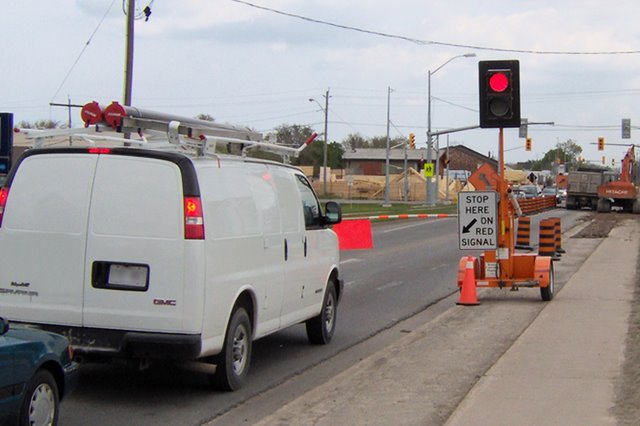Automated Traffic Control Devices Protect Flaggers from Driving Hazards
 Fatalities in the construction industry, including fatal transportation incidents, are some the most frequent type of fatal work-related events in the United States and Canada. In the United States, the Bureau of Labor Statistics preliminarily reported 1,682 fatal transportation incidents in the construction industry in 2009. In Canada, The Centre for the Study of Living Standards reported 20.6 deaths per 100,000 workers in the construction industry workers from 1993 to 2005.
Fatalities in the construction industry, including fatal transportation incidents, are some the most frequent type of fatal work-related events in the United States and Canada. In the United States, the Bureau of Labor Statistics preliminarily reported 1,682 fatal transportation incidents in the construction industry in 2009. In Canada, The Centre for the Study of Living Standards reported 20.6 deaths per 100,000 workers in the construction industry workers from 1993 to 2005.
Human flaggers and police officers directing traffic on construction sites put themselves in harm’s way every time they step into the roadway. They are often struck by passing vehicles or construction vehicles. In the U.S. alone, 265 workers were struck and killed on the job in 2009. In November 2010, a Hamilton, Ontario flagger was struck by a drunk driver, thrown into a backhoe and killed just days before his 60th birthday.
In an effort to reduce the number of tragedies caused by drunk driving and other driver impairments, contractors and municipalities across North America are replacing human flaggers with Automated Flagger Assistance Devices (AFADs) and specifically remote controlled flagging devices.
The Ontario Ministry of Transportation granted approval of AFADs, including North America Traffic’s Remote Controlled Flagman, model RCF 2.4, which allows contractors to use the device on roadways in Canada since 1994. The (U.S.) Federal Highway Administration (FHWA) included AFADs the 2009 Manual on Uniform Traffic Control Devices. The Manual defines the standards used by road managers nationwide to install and maintain traffic control devices on all public streets, highways, bikeways and private roads open to public traffic. States must adopt the 2009 National MUTCD as their legal State standard for traffic control devices by this year.
“As we work to eliminate drunk driving, contractors should use mechanical flaggers to keep human flaggers alive,” Peter Vieveen, president of North America Traffic.
Remote controlled flagmen protect workers as well as drivers in several ways:
1. First, they are operated by radio remote control from a distance of up to 1000 ft, allowing the flagger to stand off the roadway and out of danger from passing vehicles or construction vehicles backing up in the work zone.
2. One operator can control multiple units at a distance by remote control or one operator can control traffic at one end of the work zone with a stop slow paddle and control the unit at the opposite end with a remote control.
3. Drivers can see remote controlled flagmen at a further distance than human flaggers, providing them more time to slow down or stop. Remote controlled flagmen typically have red and yellow signals, so they are easily recognizable. When fully erected the signal head sits 9 ft high.
4. The cost of the remote controlled flagman has dropped in the last few years and new technology makes them very quick and easy to set up, often requiring less than a minute to set up a single device. They run on battery power charged by solar panels and provide ample runtime during the construction season. The devices are trailer-mounted and compact with tandem towing capability.
Remote control flagman devices have already been used on thousands projects throughout North America. As long as the majority of construction projects involve working on or near roads that are already in use, this safety concern will continue to grow. As more contractors and municipalities become aware of the remote controlled flagman’s safety benefits, they will become a mainstay in the road and bridge construction industry.
“Whenever I can I use a flagging device instead of a human flagger. It doesn’t make sense putting my workers at risk when I don’t have to”, said Del Voth of Peninsula Construction.






Comments are closed here.